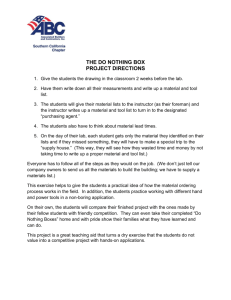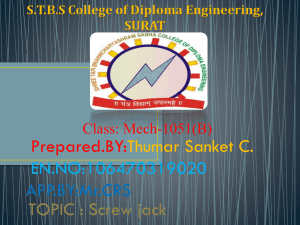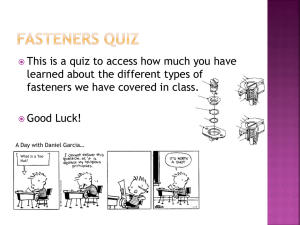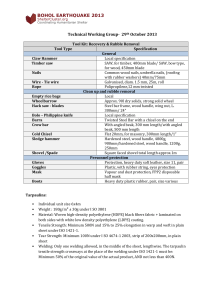psaa fasteners worksheet
advertisement
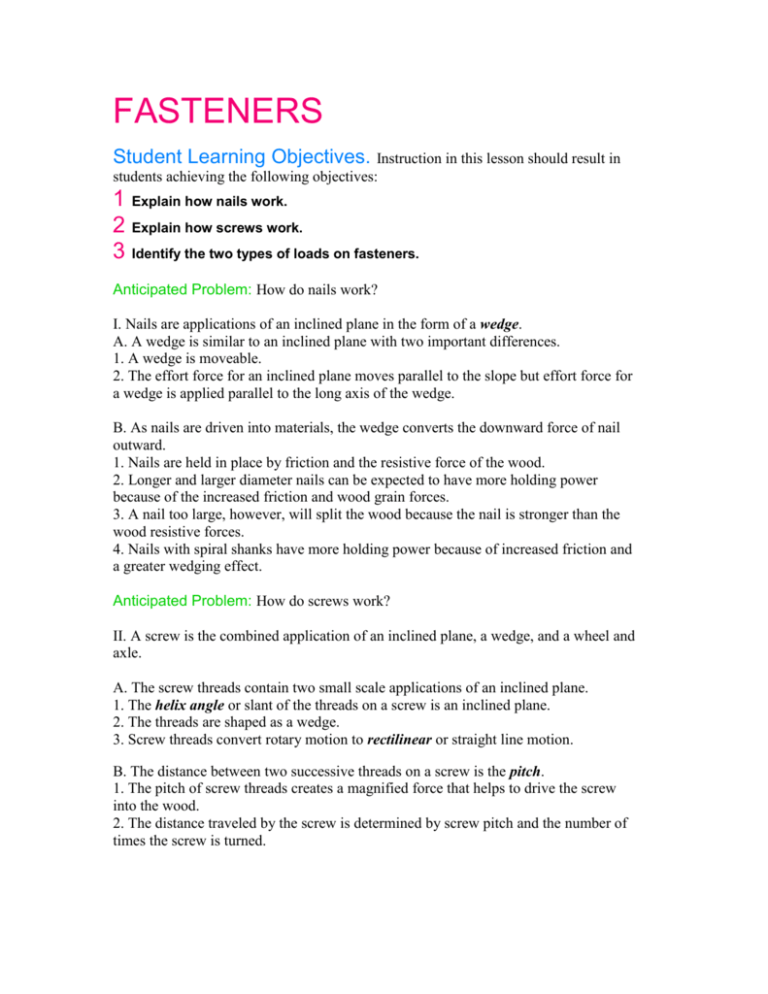
FASTENERS Illinois Physical Science Applications in Agriculture Lesson B5–2 • Page 1 Student Learning Objectives. Instruction in this lesson should result in students achieving the following objectives: 1 Explain how nails work. 2 Explain how screws work. 3 Identify the two types of loads on fasteners. Anticipated Problem: How do nails work? I. Nails are applications of an inclined plane in the form of a wedge. A. A wedge is similar to an inclined plane with two important differences. 1. A wedge is moveable. 2. The effort force for an inclined plane moves parallel to the slope but effort force for a wedge is applied parallel to the long axis of the wedge. B. As nails are driven into materials, the wedge converts the downward force of nail outward. 1. Nails are held in place by friction and the resistive force of the wood. 2. Longer and larger diameter nails can be expected to have more holding power because of the increased friction and wood grain forces. 3. A nail too large, however, will split the wood because the nail is stronger than the wood resistive forces. 4. Nails with spiral shanks have more holding power because of increased friction and a greater wedging effect. Anticipated Problem: How do screws work? II. A screw is the combined application of an inclined plane, a wedge, and a wheel and axle. A. The screw threads contain two small scale applications of an inclined plane. 1. The helix angle or slant of the threads on a screw is an inclined plane. 2. The threads are shaped as a wedge. 3. Screw threads convert rotary motion to rectilinear or straight line motion. Illinois Physical Science Applications in Agriculture Lesson B5–2 • Page 3 B. The distance between two successive threads on a screw is the pitch. 1. The pitch of screw threads creates a magnified force that helps to drive the screw into the wood. 2. The distance traveled by the screw is determined by screw pitch and the number of times the screw is turned. C. The helix angle of a screw corresponds to the angle of an inclined plane. 1. This angle should be as small as possible. 2. The greater the helix angle, the greater the force exerted by the screw as it is turned. 3. Finer threads make a shallower cut in the wood and exert a smaller force as they are turned into the material. This is why finer threads strip more easily than coarser threads. Anticipated Problem: What are the two types of loads on fasteners? III. There are two types of loads on fasteners. A. Lateral loading pulls at a right angle to the fastener and produces a lateral pressure against the wood fibers. 1. The holding capacity of wood fasteners depends upon: a. Density, specific gravity, and seasoning of the wood. b. The type and size of the fastener. c. The penetration of the fastener. d. The position of the fastener with respect to the wood grain. 2. Clinching a nail may increase lateral resistance by fifty percent of more. 3. Lateral resistance is greater than withdrawal resistance. B. Withdrawal loading pulls parallel to the fastener and tends to pull it from the wood. 1. Nails provide stronger wood joints if they are driven perpendicular to the wood grain rather that parallel to the wood fibers. 2. Tests have shown fifty to seventy-five percent less withdrawal resistance when nails are driven parallel to wood fibers. 3. Nails driven into the end of a wood piece will have less withdrawal resistance than those driven into the face or edge of a board. 4. Higher density woods provide stronger joints and better withdrawal resistances. 5. Coatings, rough surface texture, and grooved shanks also increase the withdrawal resistance. Illinois Physical Science Applications in Agriculture Lesson B5–2 • Page 4 FASTENERS Part One: Matching Instructions: Match the word with the correct definition. a. Helix angle b. Lateral load c. Pitch d. Rectilinear e. Wedge f. Withdrawal load _______1. A moveable, simple machine where the effort force is applied parallel to the long axis. _______2. Pulls at right angle to the fastener. _______3. Moving in a straight line. _______4. Pulls parallel to the fastener and tends to pull from the wood. _______5. Slant of the threads on a screw. _______6. Distance between two successive threads on a screw. Part Two: Fill-in-the-Blank Instructions: Complete the following statements. 1. Nails are held in place by _______ and the ___________ of the wood. 2. Nails with spiral shanks will have __________ holding power than common nails. 3. A nail too large will _________ the wood because the nail is stronger than the wood. 4. A screw is the combined application of an _______________, a ___________, and a _________. 5. Screw threads convert ________ motion to rectilinear or _________ line motion. 6. The distance between two successive threads on a screw is the ________. 7. The two types of loads on a fastener are _________ and _______ loading. 8. __________, ______, and ________ will increase withdrawal resistance. Illinois Physical Science Applications in Agriculture Lesson B5–2 • Page 7 Part Three: Multiple Choice Instructions: Write the letter of the correct answer. _______1. Which of the following terms describes the distance between one thread and the corresponding point on the next thread? a. lead b. pitch c. rectilinear d. helix angle _______2. Which of the following terms describes the slant or angle of the threads of a screw? a. lead b. pitch c. rectilinear d. helix angle _______3. Which of the following statements is false? a. The helix angle should be as large as possible when using fasteners. b. Friction between the spiral thread and the surrounding thread hold the screw in place. c. Larger diameter nails have greater holding power than smaller diameter ones. d. Nails with spiral shanks have greater holding power because of their greater wedging effect. _______4. Which of the following terms describes the distance that a screw thread moves with each complete revolution? a. lead b. pitch c. rectilinear d. helix angle _______5. Which of the following terms is used to describe moving in a straight line? a. lead b. pitch c. rectilinear d. helix angle _______6. Which of the following types of fasteners would be best to use to fasten 1 ½ wood to 1½ wood? a. 1½ inch nail b. 1½ inch nail with thread c. 2 inch nail d. 2½ inch nail with thread _______7. Which of the following statements is false? a. Selecting the wrong fastener can lead to breakage or weakening of a joint b. Screws bolts and nails make up the bulk of agricultural fasteners c. Fasteners can be used in small projects, building construction, machine manufacturing, and many other applications. d. The size of the material does not affect the type of fastener used. Illinois Physical Science Applications in Agriculture Lesson B5–2 • Page 8 _______8. Which of the following fasteners would have the greatest holding capacity? a. 1 inch nail b. 1 inch screw c. 1½ inch nail with threads d. 2 inch screw Part Four: Short Answer Instructions: Answer the following questions. 1. Why do longer and larger diameter nails have more holding power? 2. How is the distance traveled by the screw determined? Illinois Physical Science Applications in Agriculture Lesson B5–2 • Page 9 Assessment TS–A Technical Supplement FASTENERS 1. How do fasteners hold materials together? Fasteners hold materials together by converting a variety of forces to generate a mechanical binding force. For example, a nail converts a downward (vertical) force into a wedging force which bonds material together. A screw, an inclined plane wrapped around a cylinder, converts a downward force into a bonding force. 2. What factors affect the holding power of fasteners? Nails are affected by size, shape, configuration, angle of application, and the presence or absence of adhesives. Screws are affected by size and length, the helix angle created by the threads, the pitch of the threads, and by the presence or absence of adhesives. Bolts are affected by thread size, use of washers, and the presence or absence of adhesives. The number of fasteners used in a given area will also influence holding power. 3. How does fastener position affect holding power? Altering the position of the fastener may cause an increase or decrease in the holding power of the fastener. The angle of entrance of a nail greatly affects its holding power. However, changing the entrance angle of a screw would not affect the holding power as greatly because the helix angle on the threads and the pitch will not change. Bolts are least affected by angular position because the threads will not change. The location and number of fasteners are the most critical factors. Too many fasteners in improper locations (too close to an edge or too close together) weaken the holding power of the fasteners. Illinois Physical Science Applications in Agriculture Lesson B5–2 • Page 22
